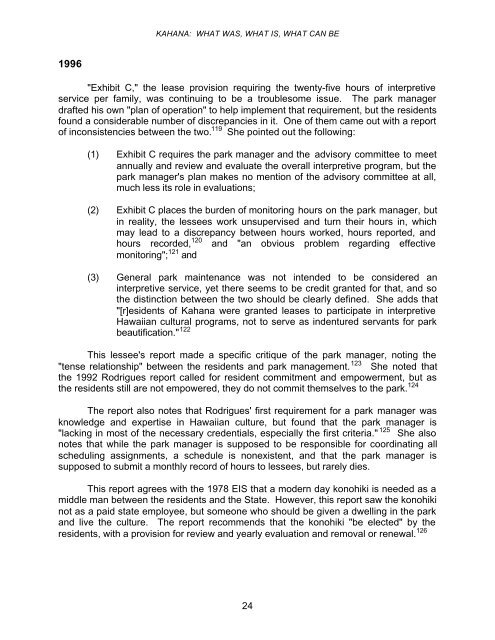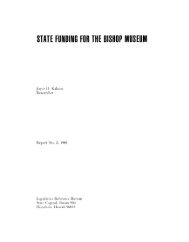Kahana: what was, what is, what can be. - Legislative Reference ...
Kahana: what was, what is, what can be. - Legislative Reference ...
Kahana: what was, what is, what can be. - Legislative Reference ...
You also want an ePaper? Increase the reach of your titles
YUMPU automatically turns print PDFs into web optimized ePapers that Google loves.
1996<br />
KAHANA: WHAT WAS, WHAT IS, WHAT CAN BE<br />
"Exhibit C," the lease prov<strong>is</strong>ion requiring the twenty-five hours of interpretive<br />
service per family, <strong>was</strong> continuing to <strong>be</strong> a troublesome <strong>is</strong>sue. The park manager<br />
drafted h<strong>is</strong> own "plan of operation" to help implement that requirement, but the residents<br />
found a considerable num<strong>be</strong>r of d<strong>is</strong>crepancies in it. One of them came out with a report<br />
of incons<strong>is</strong>tencies <strong>be</strong>tween the two. 119 She pointed out the following:<br />
(1) Exhibit C requires the park manager and the adv<strong>is</strong>ory committee to meet<br />
annually and review and evaluate the overall interpretive program, but the<br />
park manager's plan makes no mention of the adv<strong>is</strong>ory committee at all,<br />
much less its role in evaluations;<br />
(2) Exhibit C places the burden of monitoring hours on the park manager, but<br />
in reality, the lessees work unsuperv<strong>is</strong>ed and turn their hours in, which<br />
may lead to a d<strong>is</strong>crepancy <strong>be</strong>tween hours worked, hours reported, and<br />
hours recorded, 120 and "an obvious problem regarding effective<br />
monitoring"; 121 and<br />
(3) General park maintenance <strong>was</strong> not intended to <strong>be</strong> considered an<br />
interpretive service, yet there seems to <strong>be</strong> credit granted for that, and so<br />
the d<strong>is</strong>tinction <strong>be</strong>tween the two should <strong>be</strong> clearly defined. She adds that<br />
"[r]esidents of <strong>Kahana</strong> were granted leases to participate in interpretive<br />
Hawaiian cultural programs, not to serve as indentured servants for park<br />
<strong>be</strong>autification." 122<br />
Th<strong>is</strong> lessee's report made a specific critique of the park manager, noting the<br />
"tense relationship" <strong>be</strong>tween the residents and park management. 123 She noted that<br />
the 1992 Rodrigues report called for resident commitment and empowerment, but as<br />
the residents still are not empowered, they do not commit themselves to the park. 124<br />
The report also notes that Rodrigues' first requirement for a park manager <strong>was</strong><br />
knowledge and expert<strong>is</strong>e in Hawaiian culture, but found that the park manager <strong>is</strong><br />
"lacking in most of the necessary credentials, especially the first criteria." 125 She also<br />
notes that while the park manager <strong>is</strong> supposed to <strong>be</strong> responsible for coordinating all<br />
scheduling assignments, a schedule <strong>is</strong> nonex<strong>is</strong>tent, and that the park manager <strong>is</strong><br />
supposed to submit a monthly record of hours to lessees, but rarely dies.<br />
Th<strong>is</strong> report agrees with the 1978 EIS that a modern day konohiki <strong>is</strong> needed as a<br />
middle man <strong>be</strong>tween the residents and the State. However, th<strong>is</strong> report saw the konohiki<br />
not as a paid state employee, but someone who should <strong>be</strong> given a dwelling in the park<br />
and live the culture. The report recommends that the konohiki "<strong>be</strong> elected" by the<br />
residents, with a prov<strong>is</strong>ion for review and yearly evaluation and removal or renewal. 126<br />
24
















